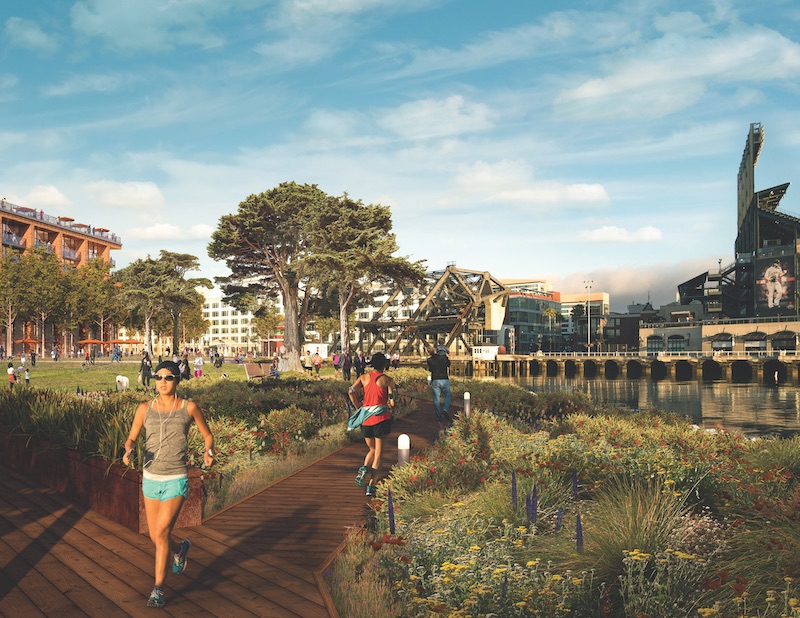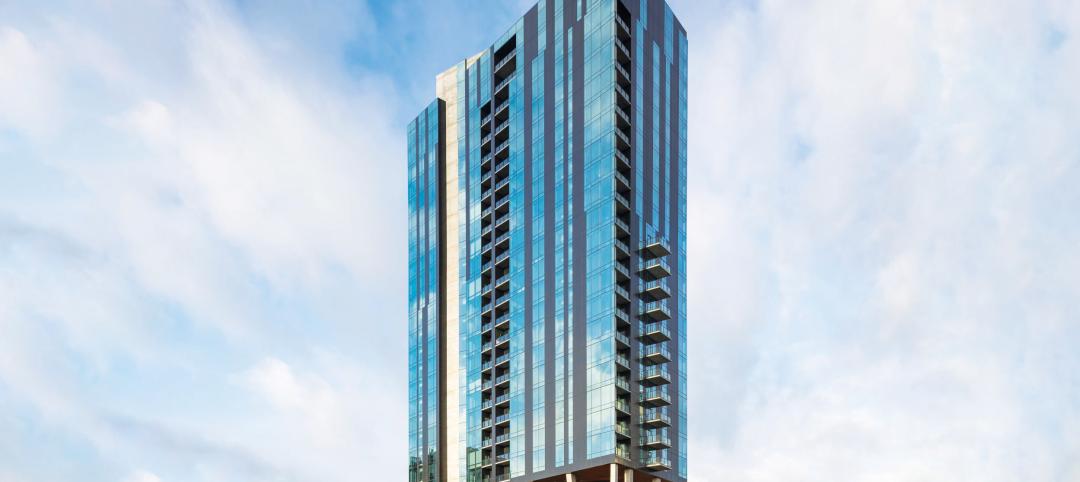On July 28, the New Jersey Department of Environmental Protection awarded AECOM and a team that includes OMA, Magnusson Klemencic Associates, and Matrix New World Engineering the final design contract for a resilience project along the Hudson River. The primary goal is to reduce flooding in Hoboken, which has 2.3 miles of coastal exposure, and parts of Weehawken and Jersey City.
The approach of this project, which HUD awarded $230 million through its Rebuild by Design contest, has four integrated resilience components:
- Resist, through a combination of hard infrastructure like bulkheads and floodwalls, and soft landscaping like berms that might double as parks.
- Delay, through policy changes and infrastructure that slow stormwater runoff.
- Store, with green and gray infrastructure improvements, such as bioretention basins and swales, to capture stormwater.
- Discharge, by enhancing stormwater management systems and upgrading infrastructure such as sewer lines.
Skidmore, Owings & Merrill, which is working on a separate project to redevelop Hoboken’s Terminal and Rail Yard into a mixed-use transit-oriented community with more than $100 million in improvements, is coordinating its efforts with the Rebuild by Design team, whose study area encompasses the terminal/rail yard.
Projects like these, where resilience is central to their design and construction, are becoming more commonplace, as developers and their AEC teams adopt positive measures to give their property assets a fighting chance of surviving the ravages of natural disasters, and to minimize recovery costs.
The replacement Ocosta Elementary School in Westport, Wash., which opened in the fall of 2016, offers a safe haven of refuge to students and residents who would have less than 30 minutes to evacuate in the event of a tsunami. The 23-classroom school includes the first vertical shelter in North America, a rooftop evacuation platform 53 feet above sea level that’s accessible via four flanking stair towers enclosed in concrete.
The platform, which is anchored by concrete piles that extend 55 feet into the ground, can hold more than 1,000 people and withstand a 9.2-magnitude earthquake and the impact of incoming waves. Resilience accounted for $2 million of the school’s $16 million project cost.
Three-thousand miles to the east, a seven-acre site with 1,700 lineal feet of shoreline along East Boston’s waterfront is being transformed into Clippership Wharf, a mixed-used development that will have 478 apartment units on two finger piers. Owner/developer Lendlease took over this project from a previous developer that had planned for lots of surface and underground parking. “That’s just not right for this day and age,” says Nick Iselin, Leadlease’s General Manager of Development. Lendlease rewrote the plan with several resilience measures, including replacing old seawalls that had been part of the site’s industrial infrastructure.
Lendlease is converting one of the piers into a “living shoreline” by creating a series of terraces for new salt marshes and a habitat for Boston Harbor, which is subject to a 10-foot tidal influence. The first floor of each building will be 24 feet above Boston City Base. All infrastructure and mechanical systems will be located above the 100-year flood level. Garage levels will be flood resistant.
To meet Boston’s “Living with Water” ordinance, Lendlease created a 1,400-foot Harbor Walk that will be 14-16 feet above the water level. In all, Clippership Wharf will have 189,830 sf of open space.
Back on the West Coast, there’s a 28-acre parking lot south of AT&T Park, where the San Francisco Giants play, that is subject to sea levels that vary as much as 24 inches. Predictions estimate those levels could rise to 66 inches by 2100.
“We needed to manage that risk,” says Kristen Hall, LEED AP, Senior Urban Designer with Perkins+Will, which has written the design controls for the proposed mixed-used redevelopment of this waterfront site, called Mission Rock. Eventually, it will encompass 11 city blocks and include eight acres of parkland, 1,500 rental units, and a million sf of office space. The Giants and the Port of San Francisco are co-developers.
The design, Hall explains, calls for the creation of a mesa down the middle of the site, with minimal frontages that may flood. She calls these frontages the site’s “sacrificial edges.” Other edges will include loading docks that create redundant elevated building access, as the majority of Mission Rock’s buildings would be at higher elevations. The park area would use a series of grade changes as design features, such as an amphitheater, a sloped lawn, steps, and ramps.
In July, the first phase of the Cornell Tech applied science campus was completed on Roosevelt Island in New York City’s East River. That phase includes The House, a residential complex with 350 apartments for staff and faculty, and Bloomberg Center, a four-story, academic building.
The buildout of this 12.4-acre, $2 billion campus is expected to proceed through 2043 and expand to two million sf. SOM, in collaboration with Cornell University and Technion – Israel Institute of Technology, is the project’s master planner. Resilience is key to protecting this property.
Colin Koop, AIA, SOM’s Design Director, explains that the East River is a tidal estuary, and significant portions of the site lie within 100- and 500-year floodplains. So all of the architecture needs to be elevated. The main pedestrian walkway, called Techwalk, will allow people to enter the campus at its periphery and then rise gently through its open spaces at a slope that is largely imperceptible. Once they reach the central ridge, they would be surrounded by permeable façades “that help create a synergy between inside and outside spaces on campus,” he says.
Cornell, says Koop, has been a “sophisticated client that is grappling with realities larger than itself and this project.”
Related Stories
Products and Materials | Jan 18, 2023
6 innovative products for multifamily developments
Here are six innovative products for various multifamily developments, including a condominium-wide smart electrical system, heavy-duty aluminum doors, and prefabricated panels.
Adaptive Reuse | Jan 12, 2023
Invest in existing buildings for your university
According to Nick Sillies of GBBN, students are increasingly asking: "How sustainable is your institution?" Reusing existing buildings may help answer that.
Sponsored | Resiliency | Dec 14, 2022
Flood protection: What building owners need to know to protect their properties
This course from Walter P Moore examines numerous flood protection approaches and building owner needs before delving into the flood protection process. Determining the flood resilience of a property can provide a good understanding of risk associated costs.
Green | Dec 9, 2022
Reaching carbon neutrality in building portfolios ranks high for organizations
Reaching carbon neutrality with their building portfolios ranks high in importance among sustainability goals for organizations responding to a Honeywell/Reuters survey of senior executives at 187 large, multinational corporations. Nearly nine in 10 respondents (87%) say that achieving carbon neutrality in their building portfolio is either extremely (58%) or somewhat (29%) important in relation to their overall ESG goals. Only 4% of respondents called it unimportant.
Green | Dec 9, 2022
Newly formed Net Zero Built Environment Council aims to decarbonize the built world
Global management consulting firm McKinsey recently launched the Net Zero Built Environment Council, a cross-sector coalition of industry stakeholders aiming to decarbonize the built world. The council’s chief goal is to collaboratively create new pathways to cut greenhouse gas emissions from buildings.
Adaptive Reuse | Dec 9, 2022
What's old is new: Why you should consider adaptive reuse
While new construction allows for incredible levels of customization, there’s no denying that new buildings can have adverse impacts on the climate, budgets, schedules and even the cultural and historic fabrics of communities.
75 Top Building Products | Nov 30, 2022
75 top building products for 2022
Each year, the Building Design+Construction editorial team evaluates the vast universe of new and updated products, materials, and systems for the U.S. building design and construction market. The best-of-the-best products make up our annual 75 Top Products report.
Seismic Design | Nov 16, 2022
SPC-4D: 7 reasons California hospital building owners should act now to meet seismic compliance
Seismic compliance with the applicable California building codes is onerous and disruptive for building owners, especially for a building in the heavily regulated sector of healthcare. Owners of older buildings that house acute care services have a big deadline on the horizon—Jan. 1, 2030, the cutoff date to upgrade their buildings to SPC-4D.
Energy-Efficient Design | Nov 14, 2022
How to achieve net zero energy in five steps
Martine Dion and Ethan Seaman share net zero energy best practices with owners and developers.
Resiliency | Nov 8, 2022
Oregon wildfire risk law prompts extensive backlash from property owners
A bipartisan bill aimed at protecting property owners from wildfires that was passed by the Oregon legislature has prompted a strong backlash.
















